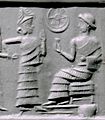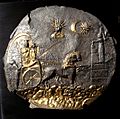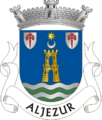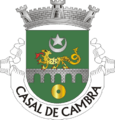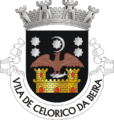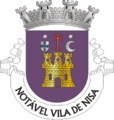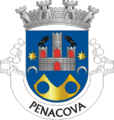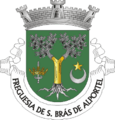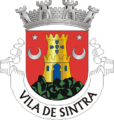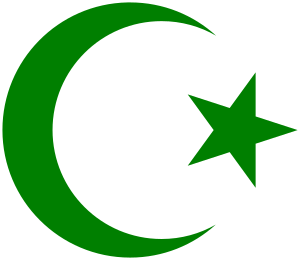
A typical presentation of the star and crescent

The flag of
Libya featuring a white crescent and star
The Star and Crescent is a well-known symbol. It shows a crescent moon with a star next to its curved side. Today, the star usually has five points, but in the past, it sometimes had more. This symbol has been used for a very long time.
For many centuries, the crescent and star, or just the crescent, was a symbol for the ancient city of Byzantium. Now, it is often seen as a symbol of Islam. You can find it on the flags of many countries, like Turkey and Pakistan.

An early star and crescent symbol from Byzantium
The Ottoman Empire was one of the first big states to use a flag with a crescent and a star. Many countries that used to be part of the Ottoman Empire also started using this symbol. This helped the symbol become very popular around the world.
The Star and Crescent Symbol
The star and crescent symbol is made up of two main parts: a crescent moon and a star. The crescent is the shape of the moon when it is less than half full. The star is usually shown with five points, making it easy to recognize.
A Symbol Through Time
This symbol has a very long history. It was used by different cultures and empires even before it became linked with Islam. For example, ancient cities like Byzantium used it. Over time, it became a strong symbol for the Ottoman Empire, which was a large and powerful empire for many centuries.
On Flags Today
Today, the star and crescent is most famous for appearing on the flags of several countries. These include:
Each country uses the symbol to represent different things, but it often stands for national identity or religious heritage.
Images for kids
-
An ancient carving showing King Ibbi-Sin with a star and crescent nearby.
-
Symbols of the Moon, Sun, and Venus on an ancient stone from the 12th century BC.
-
Symbols of Venus, Sun, and Moon on a stone from King Nabonidus (around 550 BC).
-
A coin from King Kavadh I (around 500 AD) showing the star and crescent.
-
A star and crescent on a coin from ancient Macedon (around 300 BC).
-
A star and crescent symbol with a star that looks like a sunburst (3rd century BC).
-
A coin of Mithradates VI with a star and crescent.
-
A Roman coin (1st century AD) with an eight-rayed star inside a crescent.
-
A Roman statue of the Moon-goddess Selene with stars.
-
An illustration of the goddess Selene from 1888.
-
A coin of Roman Emperor Hadrian (around 100 AD) showing a star in a crescent.
-
A Roman stone carving from Turkey showing the goddess Diana-Artemis with a crescent.
-
A star and a crescent on a coin of Orodes II of Parthia (around 50 BC).
-
A coin of Vardanes I of Parthia (around 40 AD).
-
A drawing from the 14th century showing a flag with a star and crescent in a battle.
-
A painting from the 1600s showing an emperor with a shield decorated with a star and crescent.
-
A painting from 1633 showing a shield with a star and crescent.
-
Ottoman soldiers in battle, holding a crescent banner.
-
The flag of the Rif Republic.
-
The coat of arms of Algueirão-Mem Martins, Portugal.
-
The coat of arms of Aljezur, Portugal.
-
The coat of arms of Casal de Cambra, Portugal.
-
The coat of arms of Celorico da Beira, Portugal.
-
The coat of arms of Nisa, Portugal.
-
The coat of arms of Nossa Senhora das Misericórdias, Portugal.
-
The coat of arms of Oliveira do Bairro, Portugal.
-
The coat of arms of Penacova, Portugal.
-
The coat of arms of São Brás de Alportel, Portugal.
-
The coat of arms of Sintra, Portugal.
-
The coat of arms of Sobreda, Portugal.
-
The coat of arms of Vouzela, Portugal.
-
The badge for pilots in the Turkish Air Force.
-
The flag of the Alpha Delta Phi fraternity.
-
The logo of Shriners International.
See also
 In Spanish: Creciente y estrella para niños
In Spanish: Creciente y estrella para niños

 In Spanish: Creciente y estrella para niños
In Spanish: Creciente y estrella para niños



